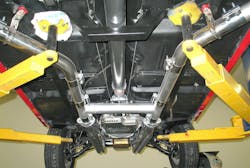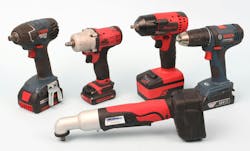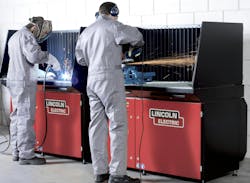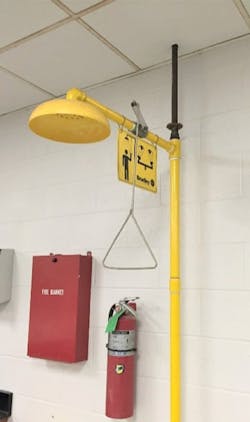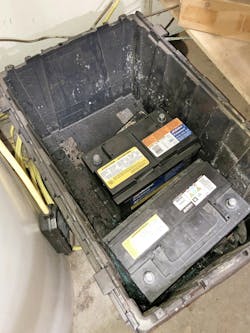Shop safety: Avoid injury and improve efficiency
The subject of shop safety covers quite a bit of ground, including personal safety and avoiding injury on the job, prevention of vehicle damage, proper use of lifts, shop ventilation, and more. Here we’ll discuss a number of these concerns.
Watch Your Back
Technicians are often subject to potential back and joint injury due to lifting heavy objects or pulling wrenches from positions that make the back vulnerable to injury.
Whenever possible, try to avoid working while bent over or reaching overhead. That’s easy to say but often difficult to avoid. During underhood service, work as much as possible at workbench height. When working over the fenders, consider raising the car to a comfortable work height to avoid back strain.
While we’re not interested in footwear fashion, it’s important to wear comfortable shoes. In addition to footwear that offers toe protection and traction, shoes or boots should provide decent arch support and a cushioned liner. Standing for hours on end can take a toll on arches, and potentially transmit strain to leg muscles and the lower back. Also, avoid shoes or boots that are a bit too short, which will easily cause annoying discomfort and cramping of the toes.
Avoid Showing Off
Granted, especially among younger technicians, it’s often tempting to “show off” by lifting heavy objects. (Granted, many of us have been guilty of this.) Demonstrating your power and dedication may seem like fun at the moment, but routinely “going the extra mile” can take its toll on your knees, hips, and lower back. Whenever possible, try to enlist the help of coworkers when handling anything heavy. What is considered “heavy” varies not only with individual size and strength, but also with the position the technician is working in. There’s no shame in asking for help — getting the job done safely without injuring yourself is more important. While straining your back and legs unnecessarily may seem like a good idea at the moment, this can, and will be unhealthy in the long term.
Lift heavy objects from the floor using your legs. Do this by bending low at the knees with the back kept straight. If you think that the object exceeds 75 pounds, get help from a co-worker.
If back pain is already a reality (and to avoid this from the get-go), stretching and strengthening exercises both relieve pain and decrease vulnerability to injury. Admittedly, not everyone enjoys working out at a gym. Regardless, in order to perform your duties while avoiding joint and muscle damage, you can do yourself a tremendous favor by routinely limbering up by stretching hamstrings and back muscles, etc. This is nothing to take lightly. While it may be tempting, especially for younger workers, to display their abilities by lifting heavy objects to impress co-workers with their strength and resilience, it’s not worth the risk. In the long term, you’ll pay dearly for this. Just ask any tech who has amassed more than 10 years on the job.
Accidents During Installation
Accidents frequently result from failure to observe basic procedures. This is especially true for underhood fires. For example, when planning to remove an engine, begin by disconnecting the battery cable to ground and plugging any disconnected fuel lines and hydraulic lines. These steps prevent fuel leakage and limit sources of ignition. Even without fuel leaks, something as simple as crossed ignition wires can start a fire in the manifold that can readily engulf the engine compartment. Always plan for the best and prepare for the worst. Establish a routine that forces you to think ahead and prepare for the worst case scenario.
Everyone in the shop building (not just techs) must be able to handle a fire extinguisher. That means knowing where each extinguisher is located and how to use them. It’s a good idea to conduct a workshop for all employees (perhaps once each year) in fire suppression. You can ask your local fire department to conduct such a class, either at your location or at the fire station. This allows everyone to gain hands-on experience in using an extinguisher. Being faced with even a “small” fire event without at least rudimentary training can easily result in a major fire. Don’t just point out where the extinguishers are located. Make sure that everyone actually knows how — and when — to use them. Naturally, in the event of a fire that you can’t immediately address, you’ll need to call the fire department, but having the knowledge to put out a small fire can spell the difference between a small amount of damage and a major blaze that can result in significant damage and injuries or even loss of life.
Remote starter switches also can lead to accidents because they bypass transmission neutral safety switches. Unless the transmission is in neutral or park, engines can start in gear and drive the vehicle forward. Place the transmission in neutral or park and set the parking brake before connecting a remote starter switch.
It is common to install engines after storing the vehicle for two weeks or more. During this time, the battery often discharges and is not recharged until installation of the rebuilt engine. The technician is sometimes in a hurry at this point and then recharges the battery at the maximum charging rate. The problem with this practice is that batteries produce flammable hydrogen gas during heavy charging. Given any source of ignition, such as arcing at a loose battery cable or other electrical connection, the hydrogen gas ignites and blows the battery apart. Avoid this hazard by trickle charging the battery two or three days ahead of time. Of course, check for loose battery cables and other electrical connections before attempting to crank the engine.
Respiratory Hazards in the Shop
Too many technicians take hazards in their work environment for granted. They routinely work around gasoline and use cleaning solvent or other special purpose chemicals, and even when such products are known to affect health, they do not think of them as really “dangerous.”
Avoid inhaling any of these products. While this seems obvious, how often do technicians use compressed air to dry solvent or chemicals from parts? How often do technicians and machinists handle worn flywheels and clutches or brake parts contaminated with friction material particles? We must consider the long range, and sometimes unknown, consequences of working around chemicals, petroleum products, and friction materials and exercise greater caution.
Begin by checking the “MSDS,” or Material Safety Data Sheet, for each product used in the shop. Second, find alternative products to replace chemicals that are particularly hazardous. For example, avoid cleaning products containing chlorinated hydrocarbons under any circumstances. Chlorinated hydrocarbons are carcinogens and accumulate in your system over time. Many technicians are unaware of potential hazards and accept unknown risks to their health by continuing to use them. Other steps required to reduce exposure are especially difficult because they involve changing work habits. For example, when using compressed air to dry parts, chemicals become airborne and subject everyone in the immediate area to respiratory hazards. Given allowable time, consider allowing parts to drain and blow passages clear later. Also consider using hot water as a rinse.
A few basic practices reduce respiratory risks. First, always work in well-ventilated areas or outside if the quantity of vapor is too great for interior ventilation systems to handle. Second, wear facemasks appropriate for either vapor or particulate hazards. Particulate hazards include dust generated by bead blasting, blowing dirty or rinsed parts with compressed air, and grinding dust from clutch or brake parts brought into the shop for machining, etc. Whenever airborne particles are involved, always wear eye, mouth, and nose protection — a respirator or disposable face mask.
General Safety Guidelines
Each piece of equipment has safety guidelines prepared for operators. Become familiar with these guidelines. Listed below are general safety rules that apply in any shop environment:
- Keep floors clean to prevent slipping on fluids or tripping over tools, parts, or air hoses.
- Wear safety glasses continuously while on the job. It is not always possible to anticipate when hazards will arise. It’s better to wear them and not need them instead of needing them and not wearing them. You’re only issued one pair of eyeballs. It only takes one mishap to result in a life-changing tragedy.
- Everyone in the shop must know the location of fire extinguishers and how to use them. This includes not only technicians but everyone, including office personnel and maintenance staff. Be diligent in making sure that all extinguishers are certified and ready for use. Take advantage of an outside fire extinguisher service company to regularly inspect and re-charge all extinguishers on a set schedule.
- Always connect exhaust pipes from running engines to outside ventilation when working inside.
- Hold a shop towel over work or holes to capture material blown loose with compressed air. Keep in mind that chips and dirt are directed across the shop unless precautions are taken. (This is yet another reason to always wear eye protection.)
- Do not siphon fuel. Drain tanks by transferring (pumping) fuel into another tank or approved gas can. Add fuel only from approved gas cans.
- Check all fuel lines and electrical connections before cranking engines.
- Meeting work deadlines is important, but regardless of how busy the shop may be on any given day, never run on shop floors. The possibility of a fall, and injury, is high.
- Always leave keys in the ignition of vehicles when parked inside the shop. This enables moving cars quickly in the event of an emergency.
- Whenever handling a battery, always wear gloves and eye protection. Wash yourself and your clothing immediately in clear water should you spill or come in contact with battery acid.
- Switch battery chargers off and wear safety glasses before connecting or disconnecting charger cables. Because battery charging produces explosive hydrogen gas, trickle charging is preferred to fast charging.
- Keep clear of exhaust manifolds, fans, and belts or pulleys when working in the engine compartment. Watch especially for electric fans because they can start without warning. Whenever working on or near moving parts (for example, while an engine is running), be aware of anything — even items on your body — that could potentially get caught. Long hair and/or long beards should be tied/tucked away. If long sleeve shirts are worn, the cuffs should be buttoned, or shirt sleeves rolled up. Avoid wearing rings, watches, or bracelets.
- Wear goggles and gloves for protection when welding or using an oxy-acetylene torch, arc, MIG or TIG welder. Remember that electric welding exposes others in the area to arc welding flash and that they may not be aware that work pieces are still hot. Set up safety screens and warn co-workers that the flash can burn eyes. Write “hot” on welded parts with soapstone or chalk. Always wear welding gloves, gas welding goggles, a welding helmet and a screen to protect others from welding flash.
- Flush skin and clothing with water if exposed to chemicals or fluids. If eyes are exposed to any contaminants, refrain from rubbing the eyes and flush with water for 15 minutes and have them checked by a doctor or nurse. Again, always wear eye protection to avoid or at least minimize the chances of eyesight injury.
- Wear only work shoes with oil-resistant soles and safety toes. If the soles of the shoes/boots become contaminated with any slippery substance, stop what you’re doing. Remove the footwear and clean/dry the soles before continuing.
- Slippery shop floors are a real hazard. Always remove and clean any floor areas of any spilled fluids, and make sure that the floor dries completely. Floor fans can aid in drying floors that have been mopped. Place yellow or orange safety markers around any wet floor area while drying.
- Check that hood supports are secure before going to work in the engine compartment. If in doubt, prop open the hood with a rod or on major jobs, remove the hood entirely.
- Immediately report even minor injuries so they may be checked and treated if necessary. Close drawers after removing tools from tool chests so that others do not catch themselves on open drawers as they pass by. To prevent sudden weight shifts and tipped over tool chests, close and lock drawers before rolling them around the shop.
Lift Safety
- Only choose a lift that features the ALI (Automotive Lift Institute) label. This indicates that the lift meets design and construction requirements.
- Know the weight of the heaviest vehicle you plan to lift and choose a lift that meets that maximum capacity.
- Before operating a lift, pay attention to your surroundings. Check the area to confirm that there are no obstructions. Lift the vehicle no more than 12 inches from the ground and pause to again to check the surrounding area. Confirm the vehicle is level as it is being lifted and check for doors that may be open.
- If using a mobile column lift, always place the lift on a firm and level surface. If using the lift outdoors, be aware of wind loads.
- All lifts should be inspected and serviced according to the liftmaker’s recommendation for scheduled maintenance. Ignoring scheduled inspections can lead to disaster. Check for proper lift points before jacking up a car or raising it on a hoist. When using a twin-post lift, make sure to use only the factory recommended lifting points. Lifting at soft areas such as the floor pans can severely dent the pans and can cause major damage. Using improper lift points can cause vehicle imbalance, which can result in the very real potential for the vehicle to slip and fall from the lift. If the vehicle owner is concerned with appearance (luxury car, restored vehicle, classic car, etc.), it’s a good idea to place clean rubber pads or shop towels between the lift pads and the vehicle to prevent marring. Never lift a vehicle immediately after placing the lift arms in position. Raise the vehicle to bring the tires just off the shop floor, then “rock” the vehicle by hand at the front and rear to confirm the vehicle is stable and not imbalanced. Once the vehicle is raised to the required height, use the lift’s control to gently lower the lift arms to its resting locking blocks. Never solely depend on the lift’s hydraulics. When using a floor jack, place safety stands under the car before continuing. Whether dealing with a lift or a floor jack, never depend on the hydraulics alone.
Benefits of Cordless Tools
Whenever practical, consider the use of cordless power tools. This eliminates the need to drag compressed air hoses around the shop floor, and reduces the risk of someone tripping over the hose. Today’s cordless power tools offer substantial torque and long-life rechargeable batteries.
Handling Hazardous Materials
Over the years, technicians have generally taken the variety of chemicals and chemical byproducts in their workplace for granted. While it is easy to view efforts at controlling these materials simply as regulatory meddling, our personal health and our environment are at stake.
Hazardous materials are defined in regulations as ignitable, reactive, corrosive, or toxic. While specific parameters for each of these characteristics are detailed in the Resource Conservation and Recovery Act (RCRA), defining characteristics include the following:
- Ignitable materials have a flash point below 140 degrees Fahrenheit or ignite spontaneously or by friction.
- Corrosive materials have a pH below 2.5 or above 12.5 and corrode steel at a rate of 0.250in or more per year at a temperature of 128 degrees Fahrenheit.
- Reactive materials are unstable, change violently, and may form explosive mixtures or generate toxic fumes.
- Toxic materials are poison if ingested or inhaled or are carcinogenic.
Information describing the contents, hazards, and first aid is included in Safety Data Sheets (previously known as Material Safety Data Sheets or MSDSs). All vendors are required to make available SDSs for the products they sell. Under “Right to Know” requirements included in regulations, shops must maintain a file of SDSs for employee reference. If uncertain of product contents, or if considering new products, check the information contained in the SDSs.
Workstations
- Change fluids or perform cooling systems services and repairs only indoors. Working outdoors increases the possibility of fluids getting into storm drains or ground water.
- Take all necessary precautions to capture fluids and wipe up spills prior to mopping floors. Since mop water is disposed of in sewers, using mops to clean up excessive quantities of oil add to wastewater treatment problems. Use absorbents and then wipe with shop towels prior to mopping.
- Drain and recycle all fluids from engine and transmission cores before shipping or storage. This reduces the potential for spilled oil getting into storm drains or ground water. Dump mop water only into drains directed to sewers.
Shop Towels
- Use absorbent cotton shop towels. Once used, disposable towels become hazardous waste.
- Store cotton shop towels in fireproof metal cans after use. While working, technicians can collect used towels in a plastic bag in their toolboxes. Launder cotton shop towels through a commercial laundry service. They are equipped to properly handle water discharges after washing.
Oils, Fluids, and Coolants
- Drain engine oils and transmission fluids into double containment units. Cover the primary container when not in use and keep the secondary side clean.
- Capture coolant and store in a separate double containment unit.
- Recycle oils and coolants to conserve resources and to avoid hazardous waste disposal handling charges.
- In case of a spill, use absorbents and/or wipe with shop towels before mopping. For small spills, wiping with shop towels is preferred since used absorbent materials require handling as hazardous waste. Report spills of more than one pound (estimated) to management. Regulatory agencies generally require that management keep a log of such spills.
Oil Filters
- Drain used filters thoroughly by puncturing the case and placing them upright in a bucket or barrel. Crushing them is even better since more can be collected per barrel, thereby reducing the cost of hauling. Collect drained or crushed filters in a closed top barrel and store in a dry place. These materials are recyclable.
Solvent
- Work only in approved solvent cleaning stations that meet requirements for vapor control and fire safety. This typically means a limited sized opening over the reservoir and a lid equipped with a fusible link that drops over the tank in case of fire. Report spills of more than one pound (estimated) to management, as a log of such spills is generally required.
Friction Materials
- While asbestos is no longer used in the making of friction materials, if you happen to work on an old (vintage) vehicle, use caution, as it is possible that original-type friction materials including clutches and brakes may contain asbestos. Even where asbestos friction material is not present, always wear face/breathing protection, as any contaminants can be harmful to ingest.
- Wash all flywheels, clutches, and brake drums or rotors before machining them and wash hands after handling. This reduces the possibility of inhaling or ingesting contaminants. Place all used clutches and other friction materials in a closed barrel and store in a dry place. These materials are recyclable or can often be returned to rebuilders as cores.
Batteries
- To reduce handling, charge batteries while still in the vehicle if possible.
- If removed from the vehicle, place them in a plastic secondary container (non-metallic) to protect against spills containing acid and lead.
- Store battery cores separate from other materials in a secondary containment unit. Battery cores are recyclable.
About the Author
Mike Mavrigian
Motor Age Editor
Mike Mavrigian has written thousands of automotive technical magazine articles involving a variety of specialties, from engine building to wheel alignment, and has authored more than a dozen books that crisscross the automotive spectrum. Mike operates Birchwood Automotive, an Ohio shop that builds custom engines and performs vintage vehicle restorations. The shop also features a professional photo studio to document projects and to create images for articles and books.






